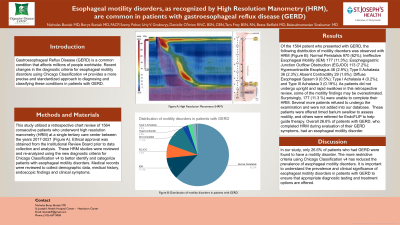Tuesday Poster Session
Category: Esophagus
P3229 - Esophageal Motility Disorders, as Recognized by High Resolution Manometry, Are Common in Patients With Gastroesophageal Reflux Disease
Tuesday, October 24, 2023
10:30 AM - 4:00 PM PT
Location: Exhibit Hall

Has Audio

Nicholas B. Buniak, MD
St. Joseph's Hospital Health Center - Heartburn Center
Syracuse, NY
Presenting Author(s)
Nicholas Buniak, MD, Borys Buniak, MD, Sonny Pohar, BS, Uriy Grabovyy, , Danielle Obrien, RNC, BSN, CBN, Tara Frey, BSN, RN, Beata Belfield, MD, Balasubramian Sivakumar, MD
St. Joseph's Hospital Health Center - Heartburn Center, Syracuse, NY
Introduction: Gastroesophageal Reflux Disease (GERD) is a common condition that affects millions of people worldwide. Recent changes in the diagnostic criteria for esophageal motility disorders using Chicago Classification v4 provides a more precise and standardized approach to diagnosing and classifying these conditions in patients with GERD.
Methods: This study utilized a retrospective chart review of 1564 consecutive patients who underwent high resolution manometry (HRM) at a single tertiary care center between the years 2017-2021. Ethical approval was obtained from the Institutional Review Board prior to data collection and analysis. These HRM studies were reviewed and re-analyzed using the new diagnostic criteria for Chicago Classification v4 to better identify and categorize patients with esophageal motility disorders. Medical records were reviewed to collect demographic data, medical history, endoscopic findings and clinical symptoms.
Results: Of the 1564 patient who presented with GERD, the following distribution of motility disorders was observed with HRM: Normal Peristalsis 970 (62%); Ineffective Esophageal Motility (IEM) 177 (11.3%); Esophagogastric Junction Outflow Obstruction (EGJOO) 113 (7.2%); Hypercontractile Esophagus 46 (2.9%); Type II Achalasia 36 (2.3%); 29 Absent Contractility (1.8%); Diffuse Esophageal Spasm 9 (0.5%); Type I Achalasia 4 (0.2%); and Type III Achalasia 3 (0.19%). As patients did not undergo upright and rapid swallows in this retrospective review, some of the motility findings may be overestimated. Surprisingly, 177 (11.3 %) were unable to complete their HRM. Several more patients refused to undergo the examination and were not added into our database. These patients were offered timed barium swallow to assess motility, and others were referred for EndoFLIP to help guide therapy. Overall 26.6% of patients with GERD, who completed HRM during evaluation of their GERD symptoms, had an esophageal motility disorder.
Discussion: In our study, only 26.6% of patients who had GERD were found to have a motility disorder. The more restrictive criteria using Chicago Classification v4 has reduced the prevalence of esophageal motility disorders. It is important to understand the prevalence and clinical significance of esophageal motility disorders in patients with GERD to ensure that appropriate diagnostic testing and treatment options are offered.
Disclosures:
Nicholas Buniak, MD, Borys Buniak, MD, Sonny Pohar, BS, Uriy Grabovyy, , Danielle Obrien, RNC, BSN, CBN, Tara Frey, BSN, RN, Beata Belfield, MD, Balasubramian Sivakumar, MD. P3229 - Esophageal Motility Disorders, as Recognized by High Resolution Manometry, Are Common in Patients With Gastroesophageal Reflux Disease, ACG 2023 Annual Scientific Meeting Abstracts. Vancouver, BC, Canada: American College of Gastroenterology.
St. Joseph's Hospital Health Center - Heartburn Center, Syracuse, NY
Introduction: Gastroesophageal Reflux Disease (GERD) is a common condition that affects millions of people worldwide. Recent changes in the diagnostic criteria for esophageal motility disorders using Chicago Classification v4 provides a more precise and standardized approach to diagnosing and classifying these conditions in patients with GERD.
Methods: This study utilized a retrospective chart review of 1564 consecutive patients who underwent high resolution manometry (HRM) at a single tertiary care center between the years 2017-2021. Ethical approval was obtained from the Institutional Review Board prior to data collection and analysis. These HRM studies were reviewed and re-analyzed using the new diagnostic criteria for Chicago Classification v4 to better identify and categorize patients with esophageal motility disorders. Medical records were reviewed to collect demographic data, medical history, endoscopic findings and clinical symptoms.
Results: Of the 1564 patient who presented with GERD, the following distribution of motility disorders was observed with HRM: Normal Peristalsis 970 (62%); Ineffective Esophageal Motility (IEM) 177 (11.3%); Esophagogastric Junction Outflow Obstruction (EGJOO) 113 (7.2%); Hypercontractile Esophagus 46 (2.9%); Type II Achalasia 36 (2.3%); 29 Absent Contractility (1.8%); Diffuse Esophageal Spasm 9 (0.5%); Type I Achalasia 4 (0.2%); and Type III Achalasia 3 (0.19%). As patients did not undergo upright and rapid swallows in this retrospective review, some of the motility findings may be overestimated. Surprisingly, 177 (11.3 %) were unable to complete their HRM. Several more patients refused to undergo the examination and were not added into our database. These patients were offered timed barium swallow to assess motility, and others were referred for EndoFLIP to help guide therapy. Overall 26.6% of patients with GERD, who completed HRM during evaluation of their GERD symptoms, had an esophageal motility disorder.
Discussion: In our study, only 26.6% of patients who had GERD were found to have a motility disorder. The more restrictive criteria using Chicago Classification v4 has reduced the prevalence of esophageal motility disorders. It is important to understand the prevalence and clinical significance of esophageal motility disorders in patients with GERD to ensure that appropriate diagnostic testing and treatment options are offered.
Disclosures:
Nicholas Buniak indicated no relevant financial relationships.
Borys Buniak indicated no relevant financial relationships.
Sonny Pohar indicated no relevant financial relationships.
Uriy Grabovyy indicated no relevant financial relationships.
Danielle Obrien indicated no relevant financial relationships.
Tara Frey indicated no relevant financial relationships.
Beata Belfield indicated no relevant financial relationships.
Balasubramian Sivakumar indicated no relevant financial relationships.
Nicholas Buniak, MD, Borys Buniak, MD, Sonny Pohar, BS, Uriy Grabovyy, , Danielle Obrien, RNC, BSN, CBN, Tara Frey, BSN, RN, Beata Belfield, MD, Balasubramian Sivakumar, MD. P3229 - Esophageal Motility Disorders, as Recognized by High Resolution Manometry, Are Common in Patients With Gastroesophageal Reflux Disease, ACG 2023 Annual Scientific Meeting Abstracts. Vancouver, BC, Canada: American College of Gastroenterology.

